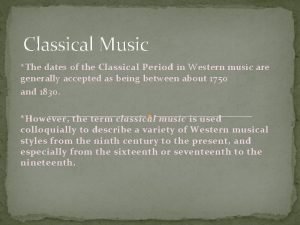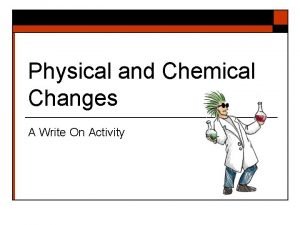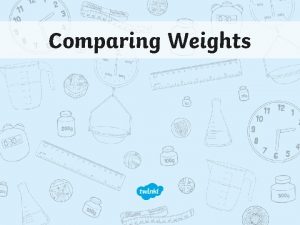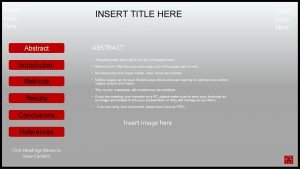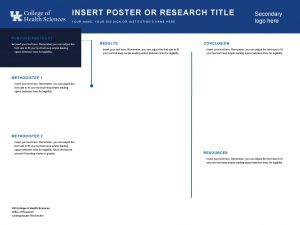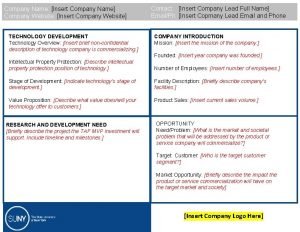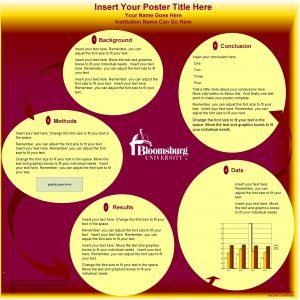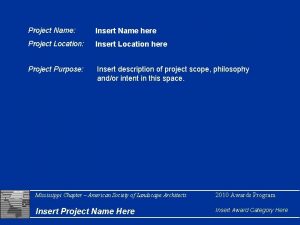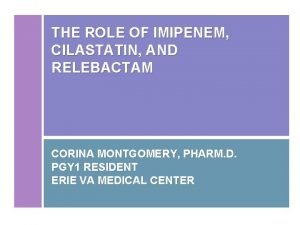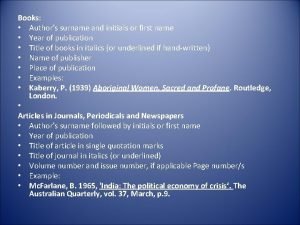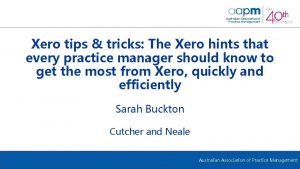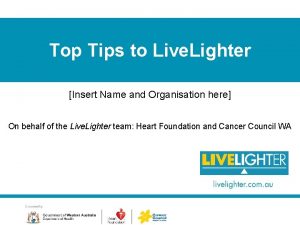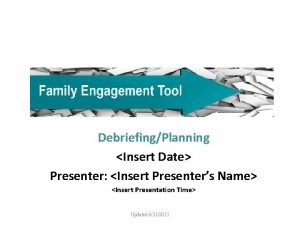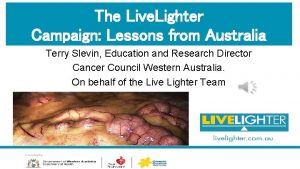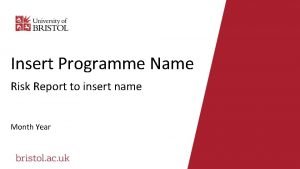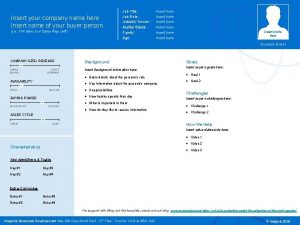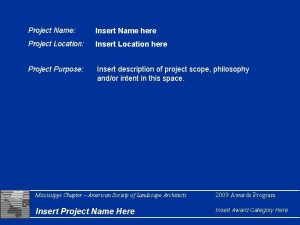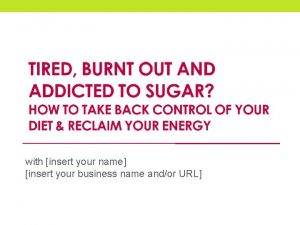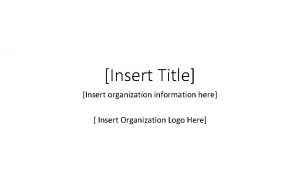Top Tips to Live Lighter Insert Name and
![Top Tips to Live. Lighter [Insert Name and Organisation here] On behalf of the Top Tips to Live. Lighter [Insert Name and Organisation here] On behalf of the](https://slidetodoc.com/presentation_image/3aa1a52c91309b797874bcad16d8f06f/image-1.jpg)






























- Slides: 31
![Top Tips to Live Lighter Insert Name and Organisation here On behalf of the Top Tips to Live. Lighter [Insert Name and Organisation here] On behalf of the](https://slidetodoc.com/presentation_image/3aa1a52c91309b797874bcad16d8f06f/image-1.jpg)
Top Tips to Live. Lighter [Insert Name and Organisation here] On behalf of the Live. Lighter team: Heart Foundation and Cancer Council WA

Overview ▲ ▲ Introduction to Live. Lighter The low-down on toxic fat and who is at risk Top tips to Live. Lighter Conclusion

Background information

Being overweight increases risk of: Heart disease ▲ Type 2 diabetes ▲ Some cancers ▲ High blood pressure ▲ Gall bladder disease ▲ Gout ▲ Impaired fertility ▲ Lower back pain ▲ Osteoarthritis ▲

What is toxic fat?

Am I at risk of toxic fat? ▲ There are two simple ways to find out if you're a healthy weight: by measuring your waistline and/or calculating your Body Mass Index https: //livelighter. com. au/The-Facts/Am-I-at-Risk

Am I at risk of toxic fat? Waist circumference Waist Circumference Your health is at risk if your waist size is Men Over 94 cm Women Over 80 cm Body Mass Index (BMI) Underweight Healthy Overweight Obese Less than 18. 5 – 24. 9 25 – 30 30 +

Live. Lighter’s Top Tips

Watch your portion size ▲ It’s important to watch the amount of food you eat to make sure you aren’t eating too much ▲ Bigger plates = bigger meals ▲ Bigger meals = more kilojoules

Watch your portion size ▲ How to control portions? ▲ Use a smaller plate ▲ Avoid going back for seconds ▲ Fill half your plate with veg ▲ Have a glass of water with your meal ▲ Eat at the table, not in front of the TV!

Avoid sugary drinks ▲ Sugary drinks include soft drinks, fruit drinks, flavoured waters, energy drinks and sports drinks ▲ These drinks are high in sugar and energy (kilojoules) and lack nutritional value ▲ Best drink choices: ▲ Water ▲ Plain reduced-fat milk

Avoid sugary drinks ▲ How to avoid sugary drinks? ▲ Drink plain tap water (or fancy it up with some fruit and herbs) ▲ Don’t buy sugary drinks ▲ Reduce the sugar you add to hot drinks (or even better don’t add any at all!) ▲ Carry a water bottle around with you ▲ Choose plain reduced-fat milk

Cut back on sugar ▲ Sugar is a type of carbohydrate ▲ Sugars are found naturally in fruits and milk products ▲ Sugars can also be added to food and drinks ▲ High levels of added sugars should be limited and can lead to: ▲ Weight gain ▲ Tooth decay

Cut back on sugar ▲ How to cut back on sugar? ▲ Avoid adding sugar to your food and drinks ▲ Limit sugary drinks and junk foods such as lollies, chocolate and biscuits ▲ Choose foods with no added sugar or with less than 5 g sugar per 100 g

Sit less ▲ Sedentary behaviour = time spent sitting or not moving very much ▲ Different from a lack of physical activity ▲ High levels of sedentary time can lead to health problems

Sit less ▲ How to sit less? ▲ Break up sitting time e. g. stand up while on the phone, go for a walk during lunch breaks ▲ Stand up during ad breaks ▲ Take regular breaks from your computer ▲ Include regular physical activity every day ▲ Walk short distances rather than driving

Cut back on salt ▲ ▲ Many Australians eat too much salt Too much salt can increase: ▲ Blood pressure ▲ Risk of heart disease ▲ Risk of stroke ▲ Risk of stomach cancer

Cut back on salt ▲ How to cut back on salt? ▲ Don’t add salt to cooking or at the table (gradually reduce the amount you add) ▲ Choose fresh foods ▲ Choose low, reduced or no-added-salt products ▲ Flavour foods with herbs and spices rather than adding salt

Cut back on alcohol ▲ ▲ Alcohol does not provide our bodies with any beneficial nutrients Alcohol can increase the amount of vitamins and minerals our bodies need Drinks such as beer, wine and spirits contain a large amount of energy (k. J) When mixed with sugary drinks, alcoholic beverages are also high in sugar

Cut back on alcohol ▲ How to cut back on alcohol? ▲ Limit alcohol to 2 standard drinks on any day ▲ Choose light beers and lowalcohol wines ▲ Dilute drinks with plenty of ice ▲ Include regular alcohol-free days ▲ Space alcoholic drinks out with water

Watch the fats you eat Saturated ▲ ▲ Should be limited Can raise cholesterol levels and increase risk of cardiovascular disease Unsaturated ▲ ▲ Include in moderation Includes both polyunsaturated and monounsaturated fats which are important for good health

Watch the fats you eat ▲ How to watch the fats you eat? ▲ Limit processed meats, pastries, biscuits, butter, cream, coconut oil/milk etc ▲ Include healthy fats from foods such as olives, nuts, seeds and oily fish ▲ Choose reduced-fat milk products ▲ Choose lean meats

Go for 2 fruit and 5 veg ▲ ▲ Eating plenty of fruit and veg helps with weight maintenance and protects against: ▲ Heart disease ▲ Some cancers ▲ Obesity ▲ Constipation Can also ↓ blood pressure and cholesterol levels and improve diabetes control

Go for 2 fruit and 5 veg ▲ How to Go for 2 fruit and 5 veg? • Have fruit or veg sticks and hummus for a snack • Base your meal around veg rather than meat • Switch meat for lentils at least once a week or add lentils to your meals • Buy canned or frozen options where available so you always have some fruit and veg on standby

Choose healthy snacks ▲ The time between meals can often be a danger zone ▲ Many snack choices are high in added sugar and saturated fats ▲ Choosing healthy snacks is essential!

Choose healthy snacks ▲ What are healthy snacks?

Be active everyday ▲ ▲ ▲ Being active is an important part of maintaining a healthy lifestyle Just 30 mins of moderate-intensity physical activity a day is needed for good health Other benefits: ▲ Reduces chronic disease risk ▲ Strengthens muscles and bones ▲ Improves mental health ▲ Helps to manage weight

Be active every day ▲ How to be more active every day? ▲ Plan for at least 30 minutes of activity per day ▲ Take the stairs ▲ Walk around while talking on the phone ▲ Cycle/walk/take public transport ▲ Get off the bus earlier and walk to your destination ▲ Gardening

Conclusion Following these top ten tips can help you to Live. Lighter and lead a healthier life

How to get more information? ▲ Visit www. livelighter. com. au Email: info@livelighter. com. au ▲ Other helpful websites ▲ Eat for Health Australian Dietary Guidelines ▲ The Heart Foundation ▲ Cancer Council ▲

Questions?
 What were the dates of the classical period
What were the dates of the classical period Top ten tips
Top ten tips Kingsford lighter fluid msds
Kingsford lighter fluid msds Is methane lighter than air
Is methane lighter than air Is lighter fluid burning a physical change
Is lighter fluid burning a physical change Steve wyborney
Steve wyborney Blue accent 1 lighter 80
Blue accent 1 lighter 80 Stereo hearts rhyme scheme
Stereo hearts rhyme scheme A is a thin lighter-weight mobile computer that has
A is a thin lighter-weight mobile computer that has To be in love gwendolyn brooks
To be in love gwendolyn brooks Comparing weights
Comparing weights Light comparative and superlative
Light comparative and superlative Name of logo
Name of logo Voice brand name
Voice brand name Insert your name
Insert your name Insert company name
Insert company name Add your title here
Add your title here Hurricane insert name
Hurricane insert name Insert your name here
Insert your name here Name a line containing point a
Name a line containing point a Quizletlive
Quizletlive Live healthy live happy
Live healthy live happy To my dear students
To my dear students My name is alvi. i live in dhaka
My name is alvi. i live in dhaka Sql insert update delete query
Sql insert update delete query Imipenem, cilastatin, and relebactam package insert
Imipenem, cilastatin, and relebactam package insert Sqi english language
Sqi english language Author surname and initials example
Author surname and initials example Stibous
Stibous Xero tips and tricks
Xero tips and tricks Alteryx tips and tricks 2021
Alteryx tips and tricks 2021 Nextgen orders
Nextgen orders
